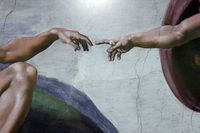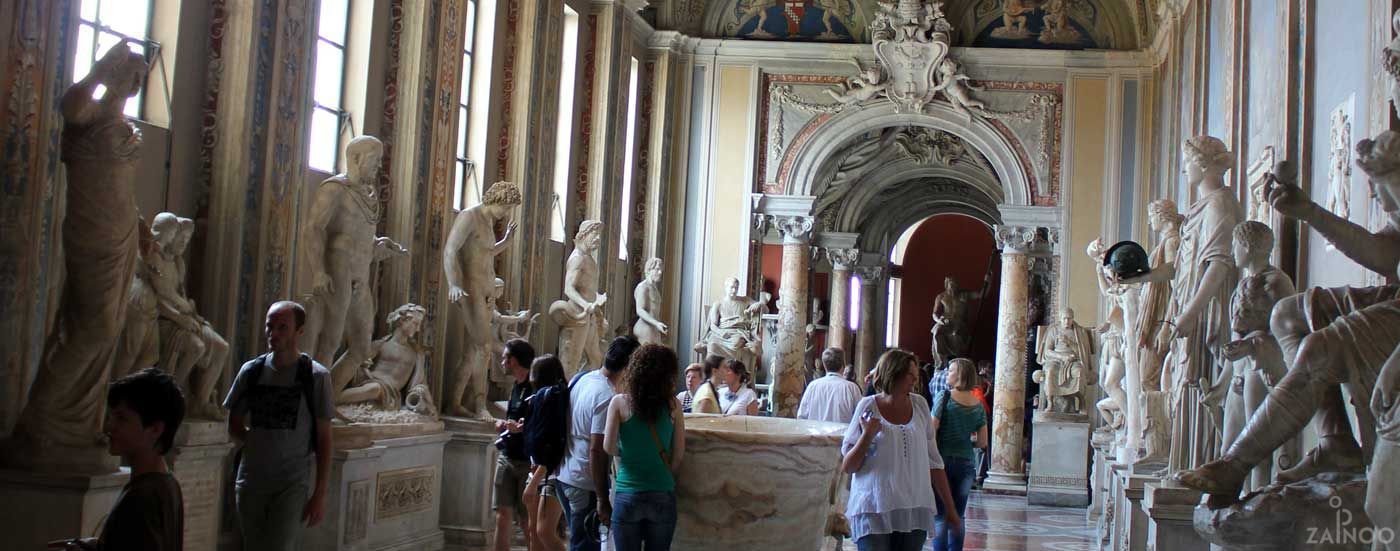Vatican Museums
Museum
Musei Vaticani - The Vatican Museums
Outstanding art and paintings collection and the Sistine Chapel
The Vatican Museums house some of the most important art collections in the world. According to the ideals of the Renaissance, Pope Julius II began the extensive collection in 1506. From all parts of the Christian world, valuable art objects have been collected and exhibited. Today the museums take up a large part of the Vatican palaces and include the famous Sistine Chapel with frescoes by Michelangelo. Four different tours lead through the extensive museums - depending on the tour they take from 1.5 to 5 hours of time.
The Pinacoteca
The Vatican Picture Gallery was established by Pius VI and houses many famous paintings from the Middle Ages to the present day in 16 halls. Highlights include the Stefaneschi triptych by Giotto in Room II, the tapestries of the acts of the apostles by Pieter van Aelst in Room VIII, the unfinished picture of St. Jerome by Leonardo da Vinci in Room IX, the Madonna for the church of San Nicolò dei Frari in Venice by Titian in Room X, "The Stoning of St. Stephen" by Giorgio Vasari in Room XI and "The Entombment of Christ" by Caravaggio in Room XII.
Museo Gregoriano Egizio, Museo Gregoriano Etrusco and Museo Gregoriano Profano
In the early 19th Century, Pope Gregory XVI founded the Gregorian museums. Next to the Egyptian Museum, which houses numerous exhibits from ancient Egypt before and during the Roman occupation, and the Etruscan Museum, which gives an impression of the life, art and culture of the Etruscans in its 18 halls, the Museo Profano deals with non-religious art. The collection includes numerous works and statues of antiquity - Greek and Roman originals and copies of sculptures, statues, reliefs and sarcophagi. Also worth seeing is the collection of vases, some of which are of Etruscan and Greek origin, which is connected to the Etruscan Museum.
Museo Pio Clementino
Thanks to the popes Clement XIV and Pius VI the Vatican Museums have the most extensive collection of ancient sculptures in the world. Numerous busts, colossal statues and portraits of gods, emperors, heroes and famous people are lined up here. Among the most impressive works are the Belvedere Torso, a powerful man's body on a rock, in the Sala delle Muse, the Candelabri Barberini from the Villa Adriana in the Galleria delle Statue, the Aphrodite of Knidos in the Gabinetto delle Maschere, the famous Apollo of Belvedere and the Laocoön group in the Cortile del Belvedere and the oil-rubbing athlete in the Gabinetto dell'Apoxyomenos.
Museo Chiaramonti
The Museo Chiaramonti was founded by Pope Pius VII of the Chiaramonti family and contains numerous ancient works of art of Greek and Roman origin. Particularly noteworthy in the Braccio Nuovo are the Augustus statue "Augusto di Prima Porta", which is a prototype for Roman statues, and the Doryphoros, the Spearman, who is regarded as the epitome and standard of all Greek statues.
Biblioteca Apostolica Vaticana and Museo Sacro
The Vatican Library is certainly one of the most valuable and richest libraries in the world. Officially founded on 15 June 1474 by Pope Sixtus IV it was steadily expanded over the centuries and today contains about 25,000 handwritten books, more than 100,000 incunabula from the Middle Ages and more than 1 million printed works up to the present time. Among the valuable exhibits are ancient scrolls, royal correspondence and records of Galileo Galilei as well as newspapers and secondary literature from the recent past. The connected Sacred Museum houses many finds from the catacombs and the early Christian churches in Rome.
Borgia Apartment and Galleria delle Carte Geografiche
The Borgia Apartment was built by the Borgia-pope Alexander VI for himself and his family at the end of the 15th Century. Pinturicchio was commissioned to paint the rooms. The beautiful murals display Christian themes along with antiquity, humanism and ancient times. The 120 metre long Galleria delle Carte Geografiche houses historical maps, cityscapes and landscapes from all over Italy. The creator was Ignazio Danti, who provides geographical information about the 16th Century.
Stanze di Raffaello
Pope Julius II commissioned the young Raphael to paint the rooms above the Borgia Apartments in 1508. The young artist not only created his masterpiece, but also raised the bar for the art world in the following centuries. While Raphael painted historical scenes, together with his teacher and his students, in the Sala di Borgo dell'Incendio, the Sala della Segnatura already represents the culmination of the High Renaissance painting. Raphael single-handedly painted three of his masterpieces here. The "Disputà del Sacramento", the "Parnassus" and the famous "Scuola d'Atene" (The School of Athens), which shows Greek representatives of the natural sciences surrounded by monumental Renaissance architecture. The following Sala d'Eliodoro clearly displays the expressive power in Raphael's pictures. Noteworthy here is primarily the "Liberation of St. Peter from prison" - Raphael's first night work with impressive lighting and backlight effects. The Sala di Costantino was completed only after Raphael's death by his students.
Cappella Sistina - The Sistine Chapel
In 1508 Pope Julius II commissioned the painter and sculptor Michelangelo to paint the Sistine Chapel. In 4 years of work, Michelangelo created the impressive frescoed ceilings and the large fresco "The Last Judgment" behind the altar. The side walls were painted by Roman painters at the end of the 15th Century. In addition to the "Last Judgment" the "Ensoulment of Adam" in the centre of the ceiling fresco is undisputedly one of the most famous images in the Sistine Chapel. The finger of God, which breathes life into Adam, is a symbol of the world famous chapel. The Sistine Chapel is not only famous for its magnificent frescoes - the College of Cardinals also meets here to elect the new pope. Above the chimney on the right wall, the believers at St. Peter's Square are informed about the outcome of each ballot – if white smoke, instead of black smoke, comes out of the chimney then one of the candidates has received a majority vote and has just been elected the new pope.
Other museums
Other museums include the Museo Pio Cristiano, which houses early Christian exhibits, sarcophagi and grave inscriptions, the Ethnological Missionary Museum with an exhibition of works from the Christian mission fields in Africa, China, South America and Australia, the History Museum, which houses the horse-carriages, cars, uniforms and weapons collection of the Vatican and the Collezione d'Arte Religiosa Moderna, the Museum of Modern Religious Art.
Entrance
€ 10,-















Tweet